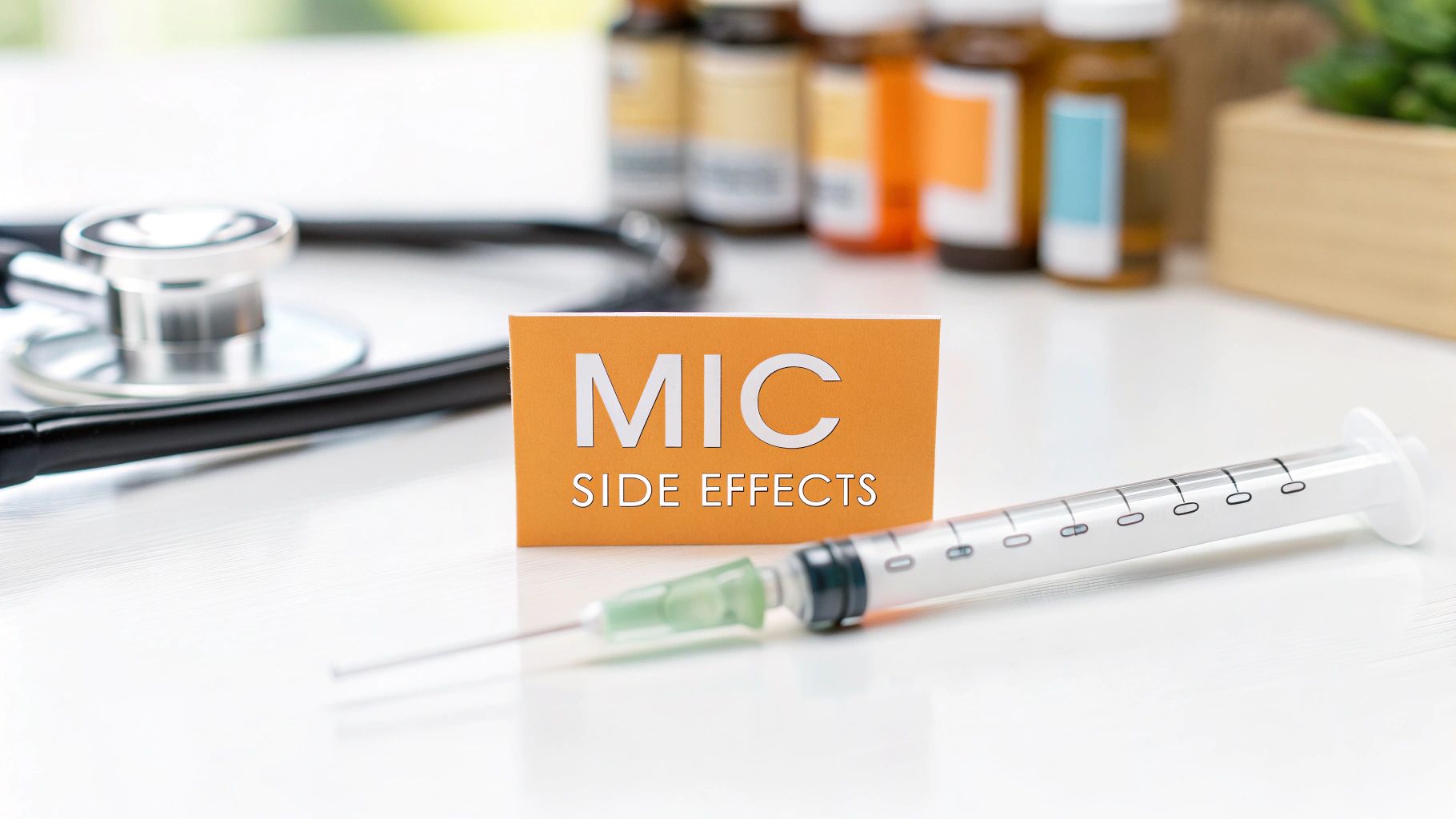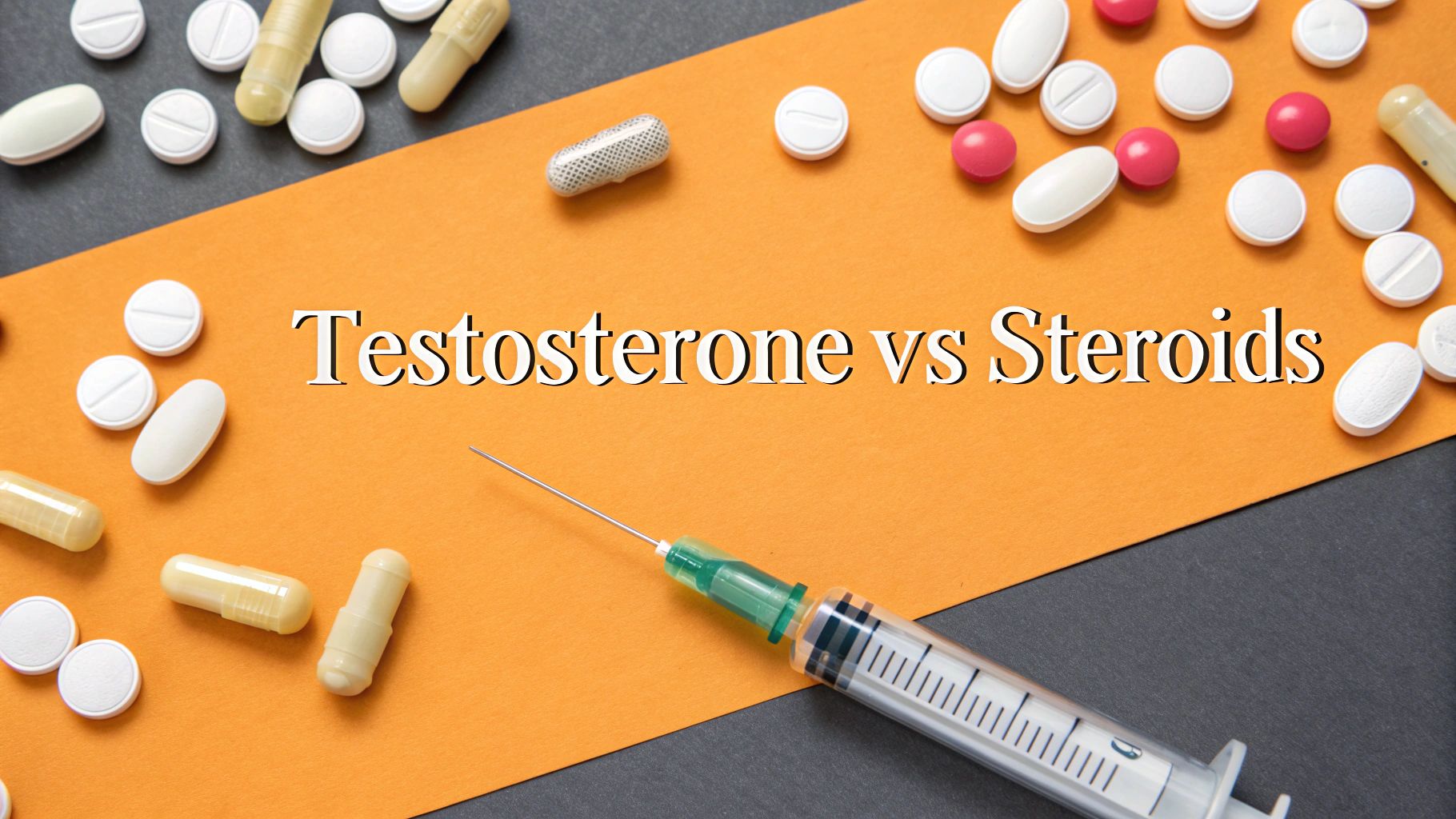Does Taking Testosterone Cause Hair Loss? The Real Answer

The short answer is: not directly. While taking testosterone can certainly speed up hair loss for some people, it doesn't just create baldness out of thin air.
The real culprit is your genetic blueprint. If male pattern baldness runs in your family, your hair follicles are likely pre-programmed to be sensitive to a powerful hormone called dihydrotestosterone (DHT). Adding more testosterone to your system simply gives your body more raw material to make DHT, essentially hitting the fast-forward button on a process that was probably going to happen anyway.
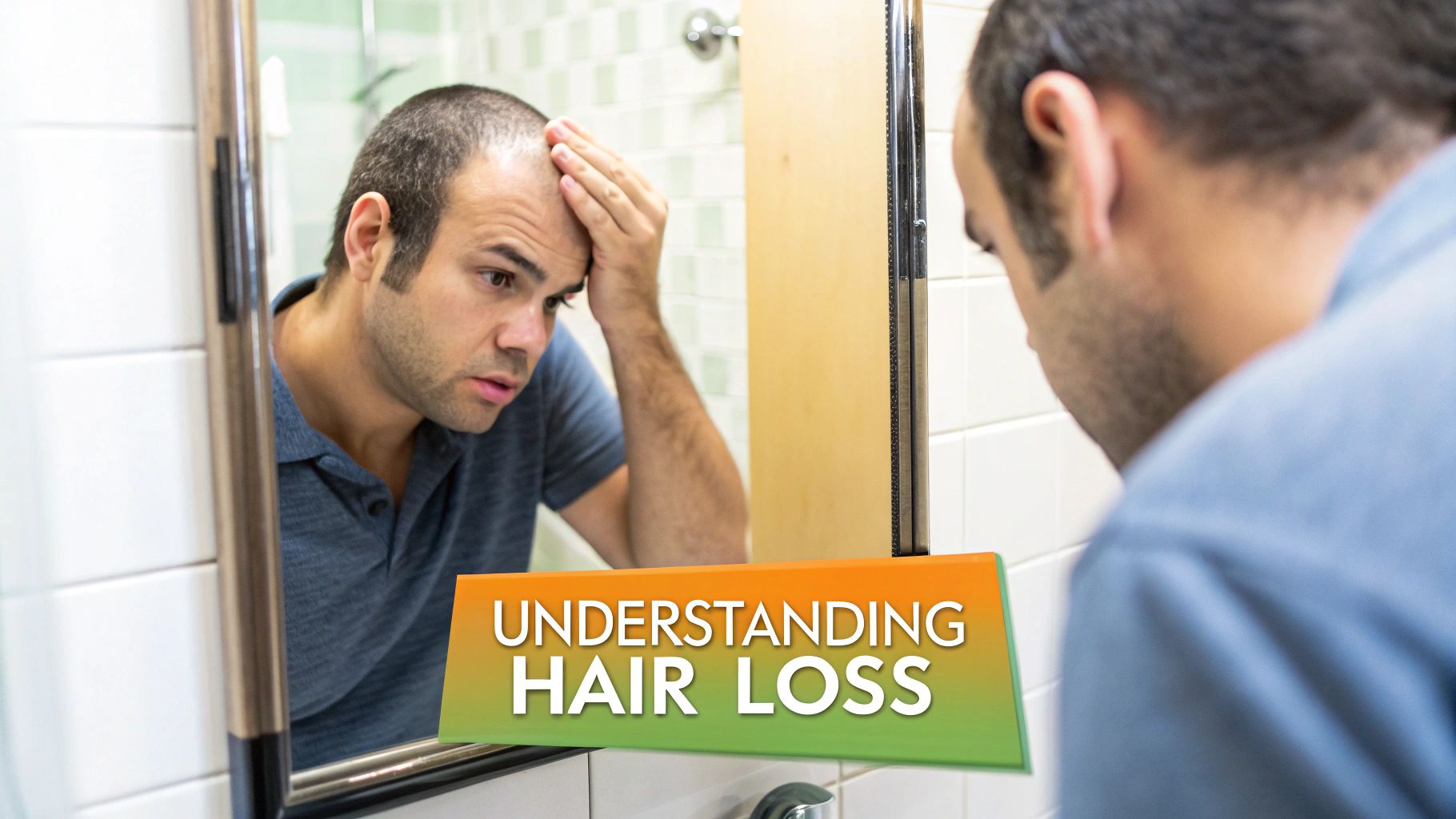
Understanding the Root Cause of Hair Loss
To really get why this happens, think of your body as a chemical factory. Testosterone is a key ingredient, but it's not the final product that messes with your hair. An enzyme in your body called 5-alpha reductase acts like a specialized assembly line, converting a portion of that testosterone into a much more potent androgen: DHT.
This is where your personal genetics become the star of the show. If your DNA has flagged the hair follicles on your scalp as being sensitive to DHT, this conversion process turns into a problem. The newly created DHT latches onto these sensitive follicles, and over time, it causes them to shrink. This process is known as follicular miniaturization.
The Miniaturization Process Explained
Follicular miniaturization isn't an overnight event. It’s a slow, gradual weakening of the hair follicle that happens with each new growth cycle.
- The hair's growth phase (the anagen phase) gets shorter and shorter.
- With each cycle, the follicle produces a hair that is finer, shorter, and less pigmented.
- Eventually, the follicle shrinks so much that it can no longer produce a visible hair at all, leading to baldness.
To quickly recap, here are the main players in testosterone-related hair loss.
Key Factors in Testosterone-Related Hair Loss
| Factor | Role in Hair Loss |
|---|---|
| Genetic Predisposition | The inherited sensitivity of your hair follicles to DHT. This is the primary "on/off" switch. |
| Testosterone | The raw material or "fuel" for the process. More testosterone means more potential fuel for DHT conversion. |
| 5-Alpha Reductase | The enzyme that acts as the "factory," converting testosterone into the more potent DHT. |
| Dihydrotestosterone (DHT) | The final product that binds to sensitive follicles, causing them to shrink and stop producing hair. |
As you can see, each element plays a distinct role. Without the genetic sensitivity, the other factors are far less likely to cause noticeable hair thinning.
The critical takeaway is that testosterone is just the fuel. Your genetic sensitivity to its byproduct, DHT, is the switch that determines whether taking testosterone will cause hair loss for you. Without that genetic switch flipped on, more testosterone doesn't automatically mean more hair loss.
This distinction is crucial for anyone considering Testosterone Replacement Therapy (TRT) or just worried about their hormone levels. It’s not the testosterone itself you should fear, but how your unique body chemistry and genetic makeup are designed to respond to it. This explains why some guys can take testosterone with zero impact on their hairline, while others start seeing noticeable thinning. Your risk was set in stone long before you ever thought about hormones—it was determined by your family tree.
How DHT Actually Causes Male Pattern Baldness
To get why taking testosterone can sometimes lead to hair loss, you have to follow the chemical journey happening inside your body. It all hinges on an enzyme called 5-alpha reductase. Think of this enzyme as a tiny, specialized factory that operates in certain tissues, including your skin and, most importantly, your hair follicles. Its main job is to convert testosterone into a much more potent androgen: dihydrotestosterone, or DHT.
When you introduce more testosterone into your system—whether through therapy or for other reasons—you’re basically giving this factory more raw material to work with. The result? A higher output of DHT. For most of your body's functions, this isn't a problem. But for hair follicles that are genetically programmed to be sensitive, this surge in DHT is the first step in a destructive process.
The Shrinking Follicle Phenomenon
Once it's created, DHT travels to the scalp and latches onto androgen receptors in the hair follicles. For those with a genetic predisposition, this binding action kicks off a damaging chain reaction known as follicular miniaturization. This isn't something that happens overnight; it’s a gradual weakening of the follicle's ability to grow a healthy, strong hair.
With each new hair growth cycle, the affected follicle starts to shrink. This has two major effects:
- Shorter Growth Phase: The anagen, or growth phase, of the hair gets progressively shorter.
- Thinner Hair Production: The hair produced by the shrinking follicle becomes finer, lighter, and weaker.
Over time, the follicle becomes so small and frail that it can no longer produce a visible hair at all, leading to the classic signs of male pattern baldness.
The infographic below shows how this process flows, starting from the intake of testosterone and ending with the miniaturization of the follicle.
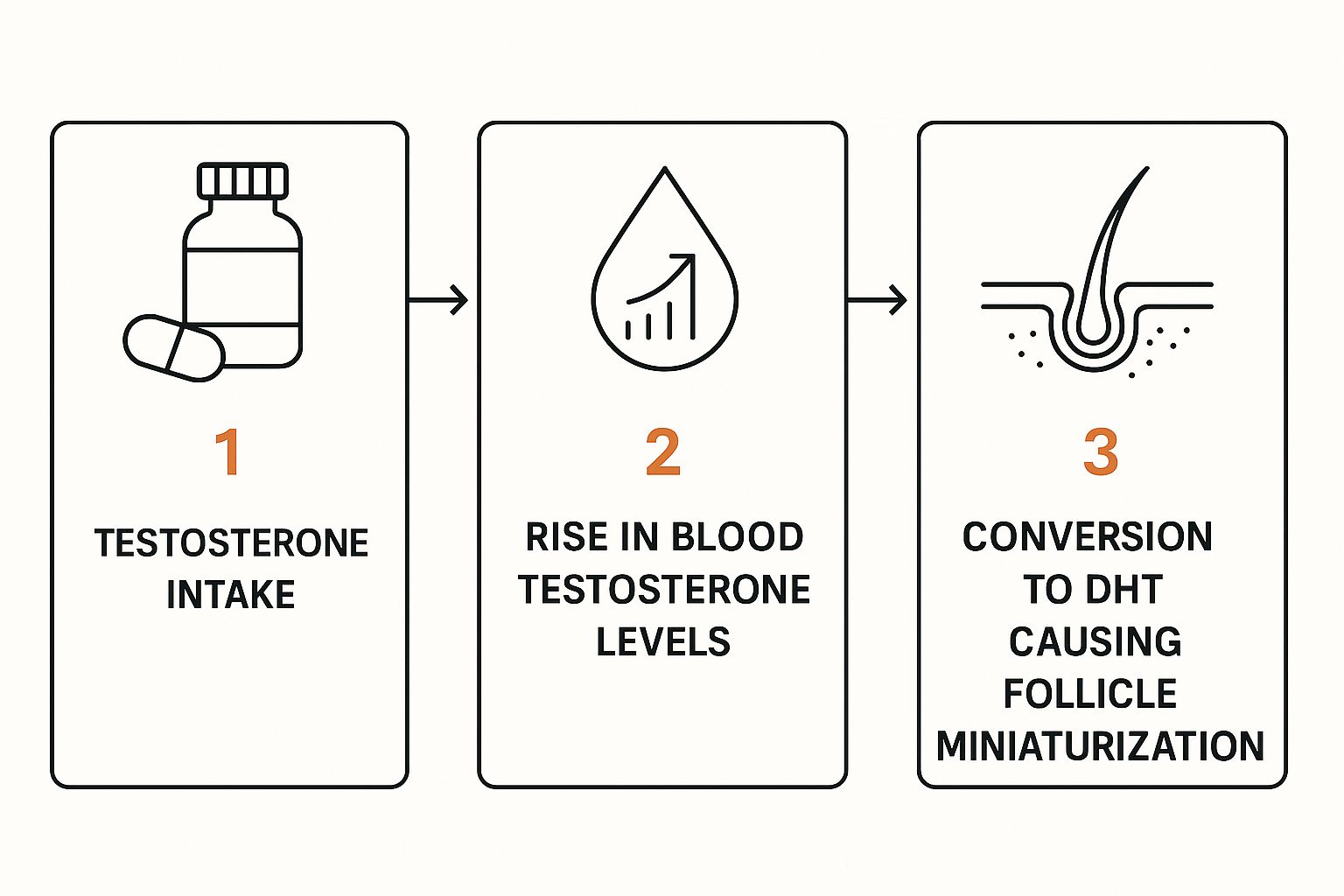
As you can see, elevated testosterone levels directly fuel the conversion to DHT, which is what causes the follicle damage responsible for hair loss.
The Central Role of 5-Alpha Reductase
This entire biochemical pathway connecting testosterone to androgenetic alopecia (the clinical term for male pattern baldness) depends on this one conversion. After puberty, DHT is responsible for many classic masculine traits, but in genetically susceptible men, it also causes unwanted effects like the shrinkage of hair follicles on the scalp. Research shows that men who are balding often have higher levels of 5-alpha reductase activity and more DHT concentrated in the thinning areas of their scalp.
The critical importance of this enzyme is proven by a fascinating genetic quirk: men born with a genetic deficiency of 5-alpha reductase do not develop male pattern baldness. You can learn more about these clinical findings on androgenetic alopecia at ccjm.org.
Key Insight: It's not the amount of testosterone in your blood that directly causes baldness. It’s the amount of DHT your scalp is exposed to and—most importantly—how sensitive your follicles are to it.
This is the very reason why some men can have sky-high testosterone levels with a full, thick head of hair, while others with lower testosterone may experience significant thinning. The ultimate deciding factor is always the genetic sensitivity of the hair follicles.
What Happens to Your Hairline on TRT?
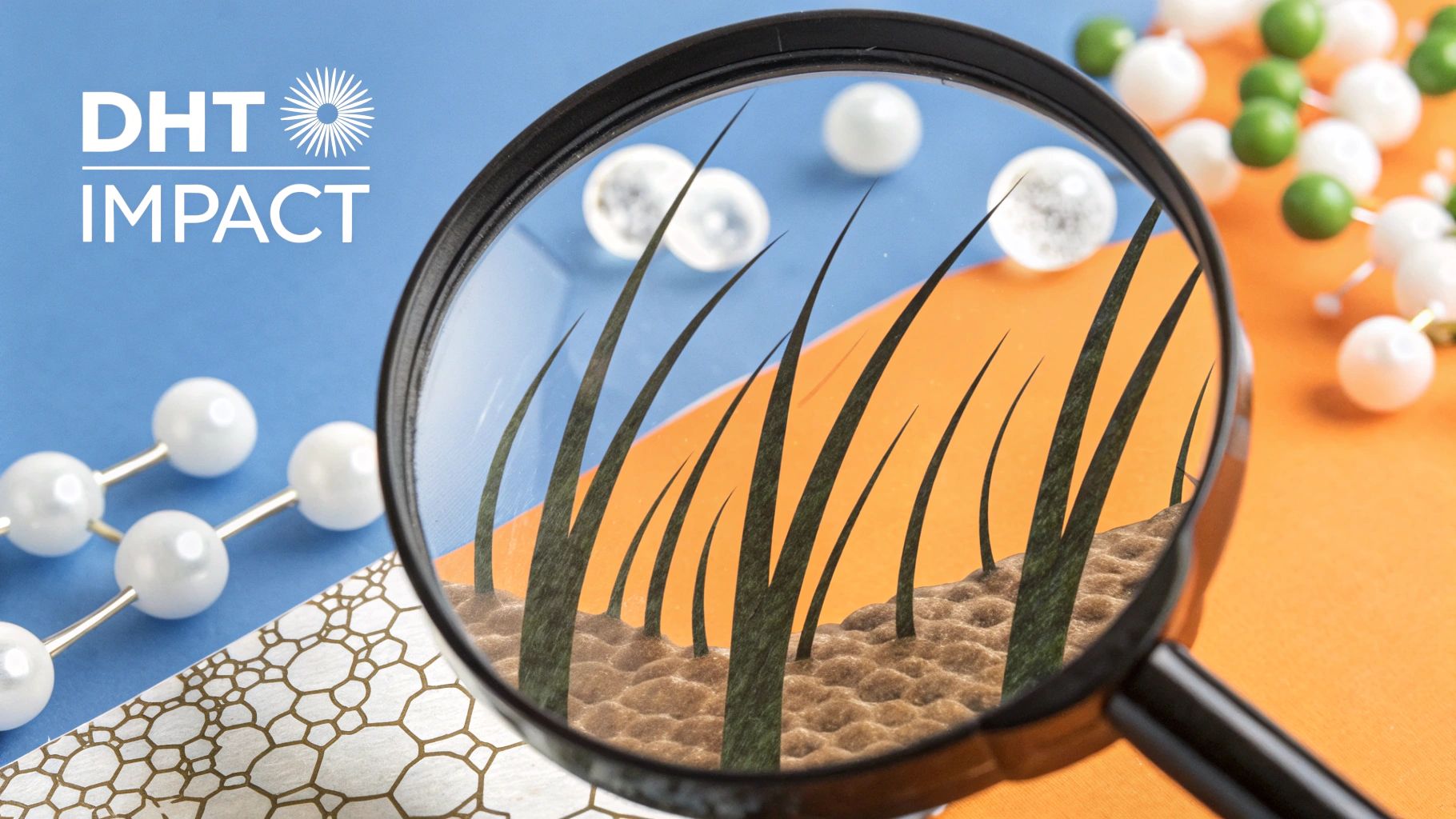
For any guy starting or just thinking about Testosterone Replacement Therapy (TRT), this is often the million-dollar question. It's important to get one thing straight from the start: the goal of TRT is to bring your hormone levels back into a healthy, normal range—not to launch them into superhuman territory.
But even when you’re just restoring testosterone to where it should be, you're still increasing the total amount of raw material your body can convert into DHT. This conversion process is the absolute center of the hair loss conversation.
For a man who is already genetically wired for male pattern baldness, starting TRT can feel like the therapy itself is directly causing his hair to thin. It’s an understandable fear, but it's more accurate to say that TRT is accelerating a process your DNA had already planned to kick off down the road.
The Acceleration Effect of TRT
Think of your genetic predisposition to baldness like a seed that was planted in your DNA the day you were born. For years, it might just sit there, dormant, or maybe sprout very, very slowly. Starting TRT is like giving that seed a steady supply of fertilizer and water. The therapy didn’t create the seed, but it creates the perfect conditions for it to grow much faster than it ever would have on its own.
This is exactly why two men can be on identical TRT protocols and see completely different results on their hairline.
- Man A (No Genetic Predisposition): He enjoys all the benefits of optimized testosterone—more energy, better mood, improved libido—with zero change to his hair.
- Man B (Genetic Predisposition): Even on a conservative dose, he starts noticing thinning at his temples or crown within a few months of starting therapy.
This is the most critical distinction to grasp. TRT simply reveals and speeds up a sensitivity that was already there; it doesn't create that sensitivity out of thin air.
The Bottom Line: TRT does not cause hair loss in men who aren't genetically susceptible. For those who are, it steps on the gas. Your family photo album is probably the best crystal ball you have.
Understanding the Clinical Reality
The link between testosterone therapy and hair loss isn't just anecdotal; it's a well-documented clinical reality. TRT is prescribed to restore normal physiological function in men with low testosterone, but this process unavoidably provides more "fuel" for the 5-alpha reductase enzyme to churn out DHT.
While the higher testosterone level itself isn't the bad guy attacking your hair, the resulting spike in DHT is. This more potent androgen can then bind to sensitive hair follicles, triggering what's called follicular miniaturization—the shrinking process that leads to finer, shorter hairs and, eventually, baldness. Experts agree that the risk is dictated entirely by this genetic sensitivity. In other words, the therapy can make existing hair loss worse, but it won't trigger it from scratch. You can take a deeper dive into the connection between androgens and hair loss on michelegreenmd.com.
Examining the Clinical Evidence on Hair Loss
The theory connecting DHT and hair follicles is solid, but what does the real-world data actually show? When we step out of the lab and into clinical studies, the evidence tells a consistent story: testosterone plays a supporting role, but it’s your genetics and DHT sensitivity that really run the show.
For years, scientists have tried to pinpoint the exact hormonal differences between men with and without male pattern baldness. Time and again, these studies reveal it’s not as simple as having high testosterone. The real story is about what your body does with that testosterone once it’s there.
The crucial finding is that men losing their hair often have higher levels of DHT and more active 5-alpha reductase enzymes—but specifically in the scalp tissue where the thinning is happening. This is a critical distinction. It means a guy could have perfectly normal testosterone levels in his blood work but still experience significant hair loss if his scalp is a hotspot for DHT conversion.
Key Insight: The battle for your hair is fought at the local level of the scalp, not just in your overall bloodstream. Higher DHT levels in the hair follicles are a much stronger predictor of hair loss than total testosterone levels alone.
This just reinforces the idea that your genetic programming is the ultimate decider. It dictates how efficiently your scalp turns testosterone into DHT and, just as importantly, how severely your follicles react to it.
Analyzing Key Study Findings
To put this in perspective, let’s look at the data. One important case-control study analyzed the hormones of 315 men, dividing them into groups with no hair loss, frontal baldness, and vertex (crown) baldness. The results were telling: men with baldness at the crown had significantly higher levels of both total testosterone and free testosterone compared to the men with no hair loss.
Another, smaller study comparing men with hair loss to a control group found the same pattern. The men losing their hair had higher testosterone and, more dramatically, much higher levels of DHT. Yet even with these clear links, researchers conclude that overall serum testosterone isn't the single cause. The real culprits are the conversion to DHT and how sensitive your follicles are to it. You can review the specifics of this research on androgens and hair loss on ncbi.nlm.nih.gov.
This body of evidence helps set realistic expectations. If you're genetically predisposed to hair loss, giving your body more testosterone through therapy will likely provide more fuel for this hair-thinning process. Understanding these nuances is a key part of managing potential hormone replacement therapy side effects. In the end, the clinical evidence confirms it: while testosterone is part of the equation, the question of whether taking it will cause hair loss really comes down to your personal genetic lottery.
How to Know If You Are at Risk
When it comes to testosterone and hair loss, your risk isn't some random roll of the dice. It’s almost entirely down to a single, powerful factor: your genetics. Your DNA holds all the cards, dictating how your hair follicles will react to androgens like DHT. This makes your family history the most reliable crystal ball you have.
The key is to look at your family tree. If you see signs of male pattern baldness on either side of your family—your dad’s side or your mom’s—those are strong clues about your own predisposition. The genes controlling your hair follicle sensitivity are the ultimate decision-makers here.
Your Personal Risk Checklist
While this is far from a diagnostic tool, answering these questions can give you a much clearer idea of where you stand. Think of it as gathering your own intel before you have a more productive conversation with your doctor.
- Does your father have significant hair loss? Look for thinning on top or a noticeably receding hairline.
- What about your maternal grandfather? The old myth that hair loss only comes from your mother's side isn't the whole story, but it’s still a very influential piece of the puzzle.
- Do your uncles or brothers show signs of balding? The more relatives you have with male pattern baldness, the higher your potential genetic risk.
The most crucial takeaway is this: Your genes determine if your hair follicles are sensitive to DHT. Introducing more testosterone simply provides more raw material for DHT conversion, potentially accelerating a process you were already destined for.
Now, while genetics are the undisputed star of the show, other factors can play a supporting role. Your age certainly influences your hair’s health, and your baseline hormone levels before starting therapy are also relevant. But these are secondary players compared to the primary influence of your genetic blueprint.
Understanding this risk profile is a fundamental part of being proactive. If you are on TRT, it's exactly why regular monitoring with a healthcare professional is so important. Ultimately, if your family photo albums are filled with generations of strong hairlines, your odds are much better. If baldness is a common theme, you’ll want to approach any testosterone therapy with a clear strategy in mind.
Proactive Strategies to Protect Your Hair

If you’ve realized you're at risk for testosterone-related hair loss, the good news is you don’t have to just sit back and watch it happen. By taking a proactive approach, you can build a strong defense to protect your hair. In my experience, a multi-pronged strategy that combines proven medical treatments with supportive lifestyle habits almost always delivers the best results.
This approach is about playing both offense and defense. You need to protect your follicles from further damage while also stimulating them to stay in their growth phase. It’s about creating a healthy environment for your hair, inside and out. The key is to start early and stay consistent.
Medical Interventions to Consider
When it comes to clinically proven solutions, two FDA-approved treatments stand out as the primary line of defense against androgenetic alopecia. It's absolutely crucial to discuss these options with your healthcare provider to see if they’re right for you.
-
Finasteride: This is a prescription oral medication that works by inhibiting the 5-alpha reductase enzyme. By blocking this enzyme, it directly reduces the amount of testosterone that gets converted into hair-damaging DHT. Think of it as shutting down the factory that produces the main culprit.
-
Minoxidil: Available as a topical solution or foam, Minoxidil works in a completely different way. It’s a vasodilator, which means it helps widen blood vessels in the scalp to improve blood flow to the hair follicles. This helps push dormant follicles back into their active growth phase and can extend how long that phase lasts.
Important Note: These treatments are not a quick fix. They require consistent, long-term use to see and maintain results. If you stop treatment, the hair loss process will likely resume right where it left off. Always consult a physician before starting any new medication.
Supportive Lifestyle and Hair Care Habits
Alongside medical options, you can reinforce your efforts with daily habits that support scalp health and hair strength. Adopting a gentle hair care routine is an excellent first step. This means avoiding harsh chemical treatments, tight hairstyles that pull on the follicles, and dialing back the excessive heat styling.
Additionally, a few smart lifestyle choices can make a meaningful difference.
- Use a DHT-Blocking Shampoo: Many shampoos contain ingredients like ketoconazole, saw palmetto, or pumpkin seed oil. These are thought to have mild DHT-blocking properties right at the scalp level, offering a localized defense.
- Optimize Your Diet: Make sure your meals are packed with hair-healthy nutrients. The essentials include biotin, zinc, iron, and Vitamin D. These nutrients are the fundamental building blocks your body needs to construct strong, healthy hair.
By combining these proactive strategies, you give yourself a complete toolkit. Discussing these options with your doctor will help you build a personalized plan to manage your hair health effectively while on testosterone.
Answering Your Questions About Testosterone and Hair
Even after digging into the science, you probably still have some specific questions running through your mind. Let's tackle some of the most common ones to make sure you have a complete picture of how testosterone, TRT, and your hair are all connected.
If I Stop Taking Testosterone, Will My Hair Grow Back?
This is the big one for a lot of guys. Stopping testosterone therapy can definitely slow down or even stop any further thinning, especially if the hair loss just started. However, it's pretty unlikely to reverse significant hair loss all by itself.
It all comes down to the current state of your hair follicles. If they're just dormant, there's a good chance they can be revived. But once a follicle has shrunk too much—a process called miniaturization—it may not be able to grow hair again without some real medical intervention.
Are Natural Testosterone Boosters Safer for My Hair?
"Natural" boosters, the kind you find online made from herbs and vitamins, are almost always far less powerful than prescription TRT. But here's the catch: if they actually work and manage to raise your testosterone, they carry the exact same type of risk, just likely on a smaller scale.
The underlying mechanism doesn't change: more testosterone can mean more DHT. The risk is directly tied to how much your T-levels actually increase. If you're curious about the science behind this, you can learn more about boosting testosterone levels in our guide.
The takeaway: Any substance that successfully increases testosterone, whether it's a pharmaceutical drug or a natural supplement, introduces the same potential risk for hair loss in men who are genetically prone to it.
Does the Type of Testosterone Administration Matter?
Not really. Whether you use injections, gels, or pellets, the delivery method doesn't fundamentally change the risk. The whole point of any of these methods is to get more testosterone into your system.
Once testosterone is in your bloodstream, your body can convert it to DHT. The factors that truly matter are your final testosterone and DHT levels and your personal genetic sensitivity—not how the hormone got there. Your focus, along with your doctor, should be on achieving stable, healthy hormone levels that work for you.
At Elite Bioscience, we believe in empowering you with both the knowledge you need and effective, medically supervised solutions. If you're ready to explore personalized TRT with a team that puts your health goals and concerns first, we're here to help. Discover our tailored therapy options at https://elitebioscience.co.
QUICK SEARCH
Make an account today to start your journey towards a better and healthier lifestyle.




